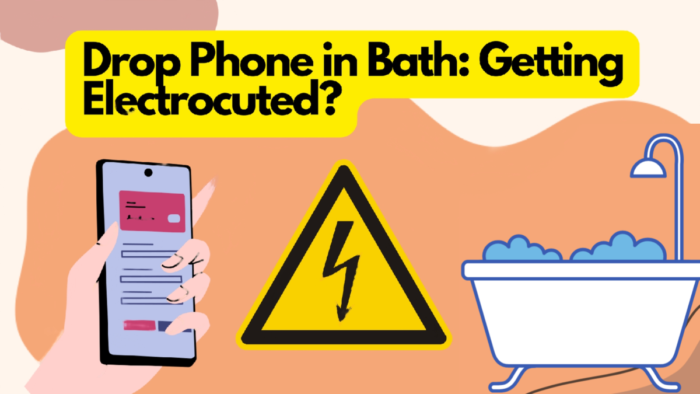In today’s fast-paced world, mobile phones have become an indispensable part of our lives. Whether we are at home or on the go, we rely on our phones for communication, entertainment, and much more. However, using our phones while taking a bath or shower can be a dangerous proposition, as it increases the risk of electric shock. In this article, we will explore the potential risks of dropping your phone in the bath and getting electrocuted. We will discuss the science behind electric shocks, the safety measures you can take to avoid such accidents, and the steps you should take in case of an emergency. So, if you are someone who frequently uses your phone while taking a bath, read on to learn more about the dangers associated with phone in bath scenarios.

Potential Mishaps When Your Phone Accidentally Plunges into a Bathtub
When it comes to electronics, water can cause serious damage. The primary concern is that water can penetrate the circuitry, enabling abnormal electrical flow out of the phone. This often results in the phone being fried, and when the circuits in the phone break, the electrical current stops. While this may reduce the risk of danger, there is no guarantee that the phone will short circuit before harmful levels of electricity are introduced to the water. The dangers of dropping a phone in a bath are based on several principles.
#1 Dangers Based on Amperage
Dangers based on amperage are a significant concern when it comes to dropping your phone in the bath. Amperage is the measurement of electrical current flowing through the body, and when a phone is dropped in the water, the current flows through the water and enters the body through any contact points. This can be a potentially lethal situation, as the current can cause severe damage to the body’s vital organs.
The severity of the damage caused by electrical shock depends on the level of amperage. A current as low as 0.01 amperes can cause a tingling sensation, while a current of 0.1 amperes can cause muscle contractions and pain. At 1 ampere, the current can cause ventricular fibrillation, which can be fatal.
When a phone is dropped in the bath, the current can flow through the water and enter the body through any contact points. This includes the hands, feet, and any other body part that is in contact with the water. The severity of the damage caused by the electrical shock depends on the level of amperage and the length of time the current flows through the body.
It is important to note that the effects of electrical shock are not always immediate. In some cases, the damage caused by the shock may not be apparent until several days or even weeks after the incident. Symptoms of electrical shock include burns, muscle pain, numbness, and tingling sensations.
To avoid the dangers based on amperage when dropping your phone in the bath, it is essential to turn off the power and avoid touching the water or the phone until the power has been turned off. It is also important to avoid using your phone in the bath, as this can increase the risk of a short circuit.
#2 Voltage Dangers

One of the dangers associated with voltage is that it can cause the phone to short circuit, resulting in permanent damage to the phone’s battery, charging port, and other internal components. When a short circuit occurs, the electrical current bypasses the intended path and instead takes the path of least resistance, which could be through your body if you’re holding the phone.
Another danger of voltage is the risk of electric shock or electrocution. If you’re using your phone in the bath, for example, and the phone is plugged in, the risk of electrocution increases significantly. This is because the water can create a path of least resistance for the electrical current to travel through your body, leading to serious injury or even death.
It’s also important to note that even if your phone is not plugged in, there is still a risk of electrocution if you’re using it in the bath. This is because the voltage from the battery can still pose a danger if it comes into contact with the water.
In order to prevent voltage dangers when using your phone in water, it’s important to avoid using it while it’s charging, and to avoid getting water into the phone’s charging port. Additionally, if you must use your phone in water, consider using a waterproof phone case to help prevent any water from getting inside.
How can you prevent yourself from getting shocked?
Some individuals have accidentally dropped their phones in bathtubs and come out unscathed, even though there is a considerable amount of electricity present in the device that could pose a danger. How did they manage to avoid getting shocked? The answer lies in three crucial concepts: waterproofing, electrical resistance, and circuit breaking.
#1 Water Resistance

When it comes to protecting yourself from shock when using your phone in water, one of the most important factors to consider is water resistance. This is a feature that can prevent water from seeping into the internal components of your device, which can cause short circuits and potentially harm you.
If you’re planning to use your iPhone in the bath or any other body of water, it’s crucial to make sure that it has the appropriate water resistance rating. Most modern iPhones have an IP68 rating, meaning they can withstand being submerged in up to 6 meters of water for up to 30 minutes without damage.
But even with water-resistant devices, it’s important to take extra precautions when using your phone in water. For example, you should avoid exposing it to high-pressure water, like from a showerhead or faucet. You should also be careful not to submerge your phone for extended periods of time, as this can still cause water to seep into its internal components.
Overall, while water resistance can certainly help protect you from shock when using your phone in water, it’s still important to be cautious and take extra steps to ensure your safety. And if you’re ever unsure about whether your phone is safe to use in water, it’s always better to err on the side of caution and avoid taking unnecessary risks.
#2 Breaks in the Circuit
When it comes to protecting yourself from electric shock, breaks in the circuit play a crucial role. A circuit break in an electronic device, such as a cell phone, is designed to stop the flow of electricity when there is a malfunction or damage to the circuit. This break in the circuit prevents a dangerous amount of electricity from reaching you and causing electric shock.
If there is no break in the circuit, then you are at risk of getting an electric shock. This shock can be particularly dangerous if it happens when you are using your phone while it is plugged in for charging. This is because the current flow is at its highest when the phone is charging, and if there is a malfunction or damage to the circuit, you may be exposed to a higher amount of electricity.
It is not uncommon to hear stories about people getting shocked by their iPhones or iPhone chargers. This is often due to breaks in the circuit not functioning properly or not being present at all. If you experience a shock while using your phone, it is important to stop using it immediately and seek professional help.
To avoid the risk of electric shock, it is essential to ensure that your electronic devices have properly functioning breaks in the circuit. If you suspect that your device may have a malfunction or damage to the circuit, it is recommended to have it checked and repaired by a professional.
#3 Conductivity of the Water
Water is an excellent conductor of electricity, which is why you should be extra cautious when using electrical devices around it. When your phone falls into the water, the conductivity of the water creates a pathway for the electricity to flow through, potentially causing electrical shock.
The amount of electricity that flows through your body depends on several factors, including the voltage, amperage, and conductivity of the water. Higher conductivity means more electricity will flow through the water, increasing the risk of electrical shock.
So, what can you do to protect yourself from the conductivity of the water? First and foremost, never use electronic devices in or around water. Keep your phone and other devices away from water sources, such as pools, sinks, and bathtubs.
Secondly, make sure your electrical devices are not damaged or have any exposed wires or circuits. A damaged device could easily cause electrical shock, even if it falls into the water for just a few seconds.
Lastly, if you do need to use electronic devices near water, make sure they are equipped with proper safety features. Many devices come with waterproofing and water resistance ratings, which can help protect against the conductivity of the water. It’s always better to be safe than sorry, so be sure to take every precaution possible to protect yourself from the conductivity of the water.







You must be logged in to post a comment.